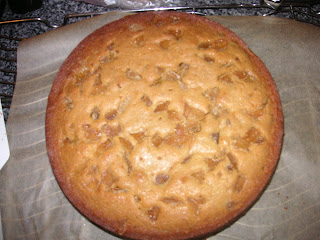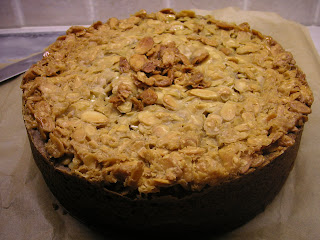
Halfway house between cake and steamed pudding, this could be eaten with a cup of tea or as dessert. It’s lighter than you might expect on glancing down the list of ingredients and really packs a punch on flavour – I defy anyone to eat this and not be able to guess what the main flavour is.
I love the fact that it uses ginger in three different forms. This photo shows them – from left to right: ground ginger, fresh ginger, crystallised stem ginger:

My tip when measuring out the wet ingredients is to measure them into the same jug. You need 170ml each of soured cream and golden syrup. If you measure out the cream, and then measure the syrup on top of it you won’t have the hassle of trying to scrape thick syrup from the bottom of the measuring jug. A picture paints a thousand words:

I should point out that the cake didn’t sink but I had a slight mishap on getting it out of the springform tin that split it a bit. Some idiot (ok, I confess it was me) when last using the cake tin put the base back in upside down; had I realised this, I would have served it from the base but I didn’t. Disaster! Don’t worry, I have suitably remonstrated myself and it won’t happen again. Anyway, here’s the cut cake:


The slices look particularly pretty with the dates dotted around the sponge and the jewelled topping of crystallised ginger:


Ingredients:
280g unsalted butter, melted and cool
2 eggs
170ml golden syrup
170ml soured cream
1 tablespoon freshly grated ginger
110g brown sugar
130g plain flour, plus an additional 2 teaspoons
130g self raising flour
1 tablespoon ground ginger (yes, tablespoon, not teaspoon)
1 teaspoon baking powder
150g dates, stoned and roughly chopped
6 pieces crystallised stem ginger thinly sliced
How to make:
- Preheat the oven to 180°C/fan oven 160°C/350°F/Gas mark 4.
- Grease a 23cm round cake tin (I used a springform).
- Melt the butter only until it is melted, you don’t want it to start browning. Set aside and leave to cool.
- Break the eggs into a large bowl and whisk only until they are combined.
- Add the golden syrup, soured cream, freshly grated ginger, brown sugar and cooled butter and beat until thoroughly combined.
- Add both flours, ground ginger and baking powder to the wet mix and beat until well combined.
- Toss the chopped dates with the extra 2 teaspoons of flour. This will ensure that they won’t stick together in a clump.
- Add to the mix and stir in ensuring the dates are well distributed.
- Pour the batter into the cake tin and level.
- Scatter the thinly sliced crystallised ginger on the top.
- Bake for 35-40 minutes or until a skewer comes out clean.
- Cool in the tin for approximately 10 minutes, then turn out onto the wire rack and allow to cool completely.
- Cake can be eaten hot or cold and reheats in a microwave should you want it with ice cream or custard for pudding. I served mine cold with some thick cream.
- Bask in glory at the wonderful thing you have made.
- Eat.

























 Yummmmmm – pudding and ice cream!
Yummmmmm – pudding and ice cream!
.JPG)
.JPG)





